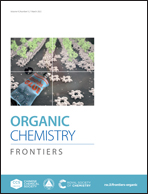Difluorocarbene-enabled access to 1,3-oxazin-6-ones from enamides†
Abstract
1,3-Oxazin-6-ones as important structural scaffolds widely exist in many bioactive or therapeutic agents. The development of straightforward synthetic approaches to access 1,3-oxazin-6-ones is highly desirable for studying their fundamental properties and applications. Herein, we report an efficient and general strategy for the construction of 1,3-oxazin-6-ones with high efficiency and chemoselectivity. Instead of using CO as a C1 source, difluorocarbene was introduced as a carbonyl provider. This method features readily available starting materials and valuable products, good functional group tolerance, and simple operation.



 Please wait while we load your content...
Please wait while we load your content...